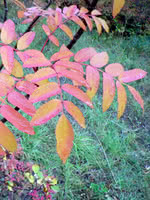Mon-Fri 9am - 5pm Mountain time
Washington Hawthorn vs Western Mountain Ash
Crataegus phaenopyrum
Sorbus scopulina
CUSTOM GROW
NOT AVAILABLE THIS SEASON - MIGHT RETURN
Washington Hawthorn is an attractive ornamental shrub that is dense enough to plant as a privacy screen. It produces clusters of white blooms in late spring to early summer.
Washington Hawthorn's red berries last throughout winter, bringing squirrels and birds to your property. In the fall, its foliage turns beautiful orange, scarlet, or purple.
One of the most overlooked trees on the prairies. This tree is often used as rootstock, a wildlife attractor, or a boulevard hedge. Give this one a second look.
This species is also known as one of the more salt-tolerant species for those with saline soils.
Please note: this plant is poisonous to dogs.
Western Mountain Ash is a popular ornamental tree native to the western part of North America. Its attractive, white clusters of flowers bloom in early summer, making way for red, yellow or orange fruit in the fall. If the fruit doesn't catch your eye, Western Mountain Ash's autumn colours will capture your–and the birds's–attention.
Washington Hawthorn Quick Facts
Western Mountain Ash Quick Facts
In row spacing: 0.9 m (3 ft)

